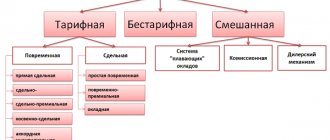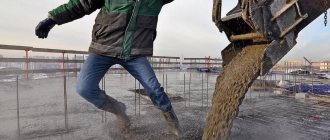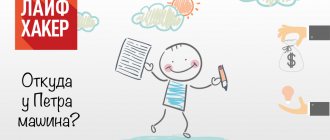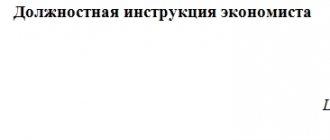Legal basis for working as a labor economist
A separate position of labor economist may be in a company on the basis of the Qualification Directory of Positions of Managers, Specialists and Other Employees, which provides for it. It was approved by Resolution of the Ministry of Labor of Russia dated August 21, 1998 No. 37.
Please note that the job description of a labor economist should not contradict this document of the Ministry of Labor.
But the labor economist’s professional standard is not legally approved. The closest thing to it is the professional standard “Labor Migration Specialist” (approved by Order of the Ministry of Labor dated October 29, 2018 No. 672n).
Note that in practice such a specialist is often called a labor rationing economist. In addition, he often deals with salary issues.
Typically, labor economist vacancies are posted by large or medium-sized organizations.
Salary level for beginners and experienced specialists
The average salary of a representative of the profession varies around 40,000-50,000 rubles. In practice, it all depends on the company where he works. Representatives of the industrial and food industries receive about 60,000 rubles. Whereas the banking sector guarantees higher earnings - approximately 80 - 100 thousand rubles.
Economists who have worked for more than three years are considered specialists. Their salary can increase by 2-3 times. Plus, we must not forget about the region where the employee works. The Moscow region and everything closer to the capital guarantees higher incomes than provincial towns.
Main job responsibilities of a labor economist
The basic list of responsibilities of an economist in the labor department at an enterprise is as follows:
- work to improve the organization of labor, forms and systems of wages, material and moral incentives;
- develops draft long-term and annual plans for labor and wages of the enterprise and its divisions, plans for increasing labor productivity and improving its organization;
- calculates wage funds and the number of employees, taking into account the need for the most rational use of labor resources, ensuring the correct ratio of workers by personnel categories and qualification categories, participates in determining the need for workers and employees, planning the training of qualified personnel, communicates planned indicators to the divisions of the enterprise;
- studies the effectiveness of the application of existing forms and systems of wages, material and moral incentives, prepares proposals for their improvement;
- develops a mechanism for distributing additional income resulting from increased labor productivity, improved product quality, reduced production costs, as well as the rental of premises and property from the placement of funds in securities;
- develops regulations on bonuses for workers and employees, conditions for material incentives for multi-machine service, combining professions and positions, increasing service areas and the volume of work performed in order to improve the use of equipment and reduce labor costs;
- participates in drawing up plans for the social development of the enterprise team, in the development and implementation of measures to strengthen labor discipline, reduce staff turnover, strengthen control over the use of working time and compliance with internal labor regulations;
- draws up staffing schedules in accordance with the approved management structure, salary schemes, wage funds and current standards, makes changes to them due to the emergence of new types of activities (positions);
- determines the amount of bonuses based on current regulations;
- control over compliance with staff discipline, expenditure of the wage fund, over the correct establishment of the names of professions and positions, the application of tariff rates and prices, official salaries, additional payments, allowances and wage coefficients, over the tariffication of work and the establishment of categories of workers in accordance with tariff and qualification reference books and categories of specialists, as well as compliance with work and rest regimes, labor legislation;
- participates in the preparation of the draft collective agreement and monitors the fulfillment of accepted obligations;
- keeps records of labor and wage indicators, analyzes them and draws up established reporting;
- carries out work on the formation, maintenance and storage of a database on labor and wages, the number of employees, makes changes to reference and regulatory information used in data processing;
- participates in the formulation of the economic formulation of problems or their individual stages, solved with the help of computer technology, determines the possibility of using ready-made projects, algorithms and application software packages that allow the creation of economically sound systems for processing information on labor and wages.
Qualification Requirements
Labor economist of category I: higher professional (economic) education and work experience as a labor economist of category II of at least 3 years.
Labor economist of category II: higher professional (economic) education and work experience as a labor economist or other engineering and technical positions filled by specialists with higher professional education, at least 3 years.
Labor economist: higher professional (economic) education without requirements for work experience or secondary vocational education and work experience as a labor technician of category I for at least 3 years or other positions filled by specialists with secondary vocational education for at least 5 years.
Required knowledge
According to the law, here is what a labor economist must know:
- resolutions, instructions, orders, other guidance, methodological and regulatory materials on the organization of labor and wages;
- labor economics;
- economics and organization of production;
- the procedure for developing long-term and annual plans for labor and wages, labor productivity, social development of the team, estimates for the use of economic incentive funds;
- forms and systems of wages and material incentives;
- methods for determining the number of employees;
- tariff and qualification reference books of works and professions of workers and qualification characteristics of employee positions;
- the procedure for tariffication of work and workers and the establishment of official salaries, additional payments, bonuses and wage coefficients, and calculation of bonuses;
- methods of accounting and analysis of labor and wage indicators;
- basics of production technology;
- the possibility of using computer technology for calculations and accounting of labor and wage indicators, the rules of its operation;
- labor legislation;
- rules and regulations of labor protection.
I. General provisions
- A labor economist belongs to the category of specialists.
- For the position:
- A labor economist is appointed a person who has a higher professional (economic) education without presenting requirements for work experience or secondary vocational education and work experience as a labor technician of category I for at least 3 years or other positions filled by specialists with secondary vocational education, at least 5 years;
- labor economist of category II - a person with a higher professional (economic) education and work experience as a labor economist or other engineering positions filled by specialists with higher professional education for at least 3 years;
- labor economist of category I - a person who has a higher professional (economic) education and work experience as a labor economist of category II for at least 3 years.
- Appointment to the position of labor economist and dismissal from it are made by order of the director of the organization on the recommendation of the head of the organization and remuneration department.
- A labor economist should know: 4.1. Resolutions, instructions, orders, other guidance, methodological and regulatory materials on the organization of labor and wages.
- 4.2. Labor economics.
- 4.3. Economics and organization of production.
- 4.4. The procedure for developing long-term and annual plans for labor and wages, labor productivity, social development of the team, estimates for the use of economic incentive funds.
- 4.5. Forms and systems of wages and material incentives.
- 4.6. Methods for determining the number of employees.
- 4.7. Tariff and qualification directories of works and professions of workers and qualification characteristics of positions of employees.
- 4.8. The procedure for tariffication of work and workers and the establishment of official salaries, additional payments, bonuses and wage coefficients, and calculation of bonuses.
- 4.9. Methods of accounting and analysis of labor and wage indicators.
- 4.10. Basics of production technology.
- 4.11. Possibility of using computer technology to carry out calculations and record indicators on labor and wages, rules for its operation.
- 4.12. Labor legislation.
- 4.13. Internal labor regulations.
- 4.14. Labor protection rules and regulations.
- 5.1. Regulations on the department of organization and remuneration.
We invite you to read: Decorating a house under the dacha amnesty - step-by-step instructions in 2020
Examination of the economist's workplace
SAFETY AND ENVIRONMENTAL FRIENDLY OF THE PROJECT
4.2. Examination of the economist's workplace
The workplace of an economist in the financial department of the Tyumen road department was chosen for the examination.
The economist occupies a separate office on the second floor in the administration building of the road department. The economist's office is equipped with air conditioning. The window openings are equipped with plastic windows that are sealed from rain and wind and have good sound insulation. The windows have blinds. At the economist’s workplace there is a single-pedestal table. There are two telephone sets, one for communication with the enterprises of the road department, the other is directly connected with the head of the financial department. The work of an economist is to collect and analyze information from economists and chief accountants of road department enterprises.
The examination includes the following sections:
— production factors that determine sanitary and hygienic conditions;
— fire hazard;
- emergencies.
Dangerous and harmful production factors affecting the economist are divided according to the nature of their action into physically dangerous and harmful production factors and psychophysiological dangerous and harmful production factors.
Physically dangerous and harmful factors affecting a person who works as an economist include: noise, factors characterizing the microclimate, lighting.
4.2.1.Noise
Noise is random sound vibrations of different physical nature, characterized by random changes in amplitude and frequency. Noise interferes with speech perception and work and has harmful effects on the human body. The noise level for highly skilled mental work that requires concentration and labor associated exclusively with conversations via communications should not exceed 55 dB A [8]. There are practically no sources of noise in the economist’s workplace, and people are protected from external sources by soundproof plastic windows, and it follows that the noise level does not exceed that established by GOST.
4.2.2.Factors characterizing the microclimate
These primarily include air temperature, relative air humidity, and air speed.
When working with neuro-emotional stress, the optimal air temperature in the room should be within 22-24 degrees Celsius, its relative humidity should be 40-60%, and the air speed should be no more than 0.1 m/s [9 ]. Based on the fact that the microclimate in the economist’s workplace is controlled by air conditioning, we can come to the conclusion that the factors characterizing the microclimate in this workplace meet the requirements of GOST.
4.2.3.Lighting
Lighting is the creation of a luminous flux falling on the surface of objects, providing the possibility of visual perception of these objects. Lighting is divided into two types: artificial lighting and natural lighting. Artificial lighting is lighting created by lighting devices, which, in particular, include lamps of various types. The use of natural light is possible only during daylight hours, with the exception of cloudy days.
In offices and workrooms, work surfaces should be located at a height of 0.8 m from the floor, the illumination of the working surface should be at least 300 lux, the discomfort index should be 40, the light pulsation coefficient should be 15%, and the natural light coefficient KEO should be 1 [10]. The economist's workplace meets these requirements and is equipped in accordance with SNiP with local plug sockets for table lamps and other lighting devices, as well as fluorescent lamps.
A fluorescent lamp is a low-pressure gas-discharge light source, the luminous flux of which is determined mainly by the glow of phosphors under the influence of ultraviolet radiation from an electrical discharge.
The diagram of their location, as well as the location of window openings, is shown in Figure 17.
4.2.4. Psychophysiological dangerous and harmful factors
Psychophysiological dangerous and harmful factors that affect a person working as an economist include:
- mental stress;
— overvoltage of analyzers;
- monotony of work;
- emotional overload.
Mental overstrain is caused by a large amount of information that needs to be analyzed, and in order to avoid mental overstrain, it is necessary to take short breaks during the working day, lasting no more than 5 minutes.
Analyzers include all sense organs, but when working as an economist, a person only experiences overstrain of the organs of vision and hearing. To avoid this, it is recommended to alternate work that mostly involves straining the organs of hearing (conversations via communications) with work that involves straining the organs of vision (compiling tables with operational information).
|
Authority
The economist must communicate closely with the company's management, proposing the most profitable solutions to optimize the operation of the enterprise and generate income. The specialist has the right to review the company’s design solutions, various documentation and, based on the analysis, report to management about detected shortcomings and opportunities for eliminating them.
Communicate with structural units and request information from them within the limits of their competence. Act according to your competence.








